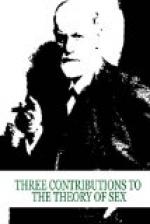The case becomes pathological only when the striving for the fetich fixes itself beyond such determinations and takes the place of the normal sexual aim; or again, when the fetich disengages itself from the person concerned and itself becomes a sexual object. These are the general determinations for the transition of mere variations of the sexual impulse into pathological aberrations.
The persistent influence of a sexual impress mostly received in early childhood often shows itself in the selection of a fetich, as Binet first asserted, and as was later proven by many illustrations,—a thing which may be placed parallel to the proverbial attachment to a first love in the normal ("On revient toujours a ses premiers amours"). Such a connection is especially seen in cases with only fetichistic determinations of the sexual object. The significance of early sexual impressions will be met again in other places.
In other cases it was mostly a symbolic thought association, unconscious to the person concerned, which led to the replacing of the object by means of a fetich. The paths of these connections can not always be definitely demonstrated. The foot is a very primitive sexual symbol already found in myths.[18] Fur is used as a fetich probably on account of its association with the hairiness of the mons veneris. Such symbolism seems often to depend on sexual experiences in childhood.[19]
(b) Fixation of Precursory Sexual Aims
The Appearance of New Intentions.—All the outer and inner determinations which impede or hold at a distance the attainment of the normal sexual aim, such as impotence, costliness of the sexual object, and dangers of the sexual act, will conceivably strengthen the inclination to linger at the preparatory acts and to form them into new sexual aims which may take the place of the normal. On closer investigation it is always seen that the ostensibly most peculiar of these new intentions have already been indicated in the normal sexual act.
Touching and Looking.—At least a certain amount of touching is indispensable for a person in order to attain the normal sexual aim. It is also generally known that the touching of the skin of the sexual object causes much pleasure and produces a supply of new excitement. Hence, the lingering at the touching can hardly be considered a perversion if the sexual act is proceeded with.
The same holds true in the end with looking which is analogous to touching. The manner in which the libidinous excitement is frequently awakened is by the optical impression, and selection takes account of this circumstance—if this teleological mode of thinking be permitted—by making the sexual object a thing of beauty. The covering of the body, which keeps abreast with civilization, serves to arouse sexual inquisitiveness, which always strives to restore for itself the sexual object by uncovering the hidden parts. This can be turned




